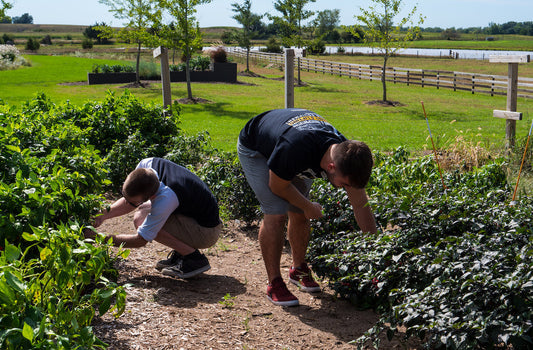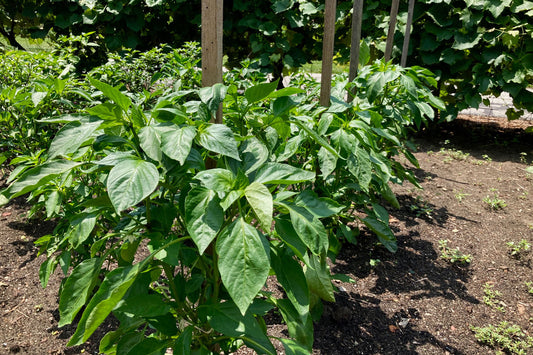If you're struggling to get your peppers to germinate, then you may have heard about the solution of soaking your pepper seeds to increase plant production. The theory goes that by soaking your seeds before planting, you increase their likelihood of sprouting and speed up the time it takes for them to germinate. But how successful is this method?
Watch our video as we conduct our own experiment to determine if pre-soaking seeds is really worth doing. If you're curious about soaking your pepper seeds before growing, try it out on any pepper seed variety and let us know what your growing results look like!
Why Soak Your Pepper Seeds?
Your pepper seeds consist of hard shell casings, protecting matter that eventually breaks through these exteriors and flourish into fresh, vibrant pepper plants. But sometimes, your seed shells may be too thick or too strong for the sprout to break through, keeping these pepper seeds dormant.
The idea behind soaking pepper seeds is that the liquid solution will soften the shells of the seeds, allowing the roots to break free sooner than just planting the seeds directly into the soil. This is especially done with seeds that have thicker shells, as they are more likely to be affected by the soaking method compared to seeds with thinner shells.
Our Soaking Pepper Seeds Experiment
We wanted to try this method out for ourselves to see if soaking pepper seeds before planting them was truly worth it. Our team of pepper growing experts decided to conduct their own experiment by growing three seed samples using different soaking methods: dry seeds, seeds soaked in water, and seeds soaked in chamomile tea. They used the same seed stock - Kristian Pepper Seeds - for all three tests, as well as the same growing conditions for each of the three experiments.

Dry Pepper Seeds
For the first method, our team planted 72 pepper seeds directly into the soil without any soaking. The sole purpose of this helps our team know how much, of if at all, soaking your seeds makes a difference.

Water-Soaked Pepper Seeds
For the soaking technique, we decided to use a two different methods to distinguish if different soaking solutions would make any difference. The first of these two involved soaking our pepper seeds in regular tap water.
We put 72 seeds across 4 cups (18 seeds per cup) submersed in water for 8-12 hours before planting them into the soil.

Seeds Soaked in Chamomile Tea
The second soaking technique, and the last of the three tests, involves soaking pepper seeds in chamomile tea. This is a common solution used by many growers to help increase germination. Chamomile tea is also said to kill any bacteria living on your seeds.
Similarly to our water-soaked seed sample, we put 72 seeds across 4 cups and let them soak in this solution for 8-12 hours, removing them and immediately sowing them directly into the soil.
How to Make Chamomile Tea:
- Boil your water.
- Pour hot water into a glass with the tea bag inside it.
- Rest for 2 minutes and remove the tea bag.
- Allow the tea to cool down to room temperature.
Our Results
After letting our Kristian pepper seeds germinate across our three samples, our team tallied up the number of sprouts for each batch and draw a conclusion on which method was the best based on the experiment.
To start, the results of the dry seeds showed that out of the 72 planted seeds, only 56 sprouted for a sample germination rate of 78%.

We were surprised to find out that out of the 72 water-soaked pepper seeds that only 47 sprouted for a lower sample germination rate of 65%.
Based on how the sprouts look at the end of the experiment, the stood up slightly longer than the dry pepper seeds sample.

And even MORE surprising was that our of the 72 seeds soaked in chamomile tea, only 44 sprouted for an even lower sample germination rate of 61%!
Similar results with water-soaked pepper seeds, with a little fuller sprouts than the dry seeds.

Conclusion
With our team's results, they did not notice any significant differences when it came to how soon the plants actually germinated. And after finalizing the numbers, the team found it didn't make a difference which method - soaking vs. non-soaking - was used on pepper seeds.
One limitation to consider with this experiment is the viability of the pepper seeds. Normally, you could do the water test on them to see if they were viable or not. Unfortunately, we could not test this out on our dry pepper seeds sample, as it would have been counterintuitive to the experiment.
Another limitation would be the seed variety. Different seeds have different time of maturing. Choosing a different seed stock for another experiment will likely yield different results.
Let's be clear: we're not saying that soaking your pepper seeds is a bad thing. This method has been proven to work on other seed varieties. However, the effects of this method are shown more with seeds that have thicker casings. And who knows, if our growing experts try this out with another seed variety, maybe we'll get results showing that soaking your pepper seeds before planting does work.
Interested in trying your own experiment? Browse through our selection of Pepper Seeds and be sure to pick up some Growing Supplies too!







